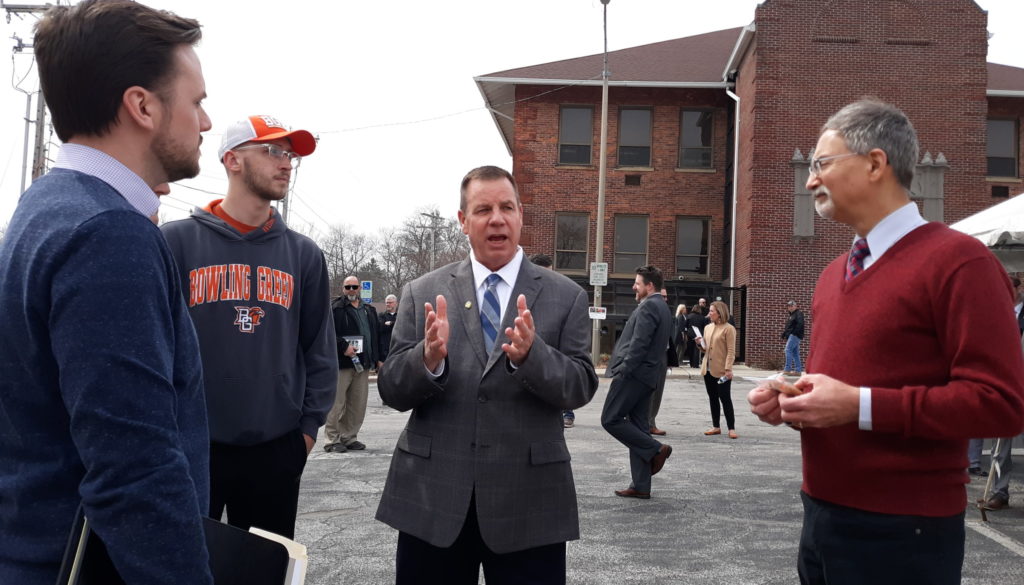By JAN LARSON McLAUGHLIN
BG Independent News
For 22 years, Bowling Green leaders have been talking about a new city building. On Tuesday, they officially broke ground for the new $11 million City Administrative Services Building.
That first meeting in 2000 was called by former municipal administrator John Fawcett and former mayor John Quinn.
“This was a long time coming,” Fawcett said Tuesday as the ceremonial shovels hoisted dirt from the site. “I’m very excited, not only for the community, but for the mayor and the administration.”
The site chosen for the new city building – the former senior center at 305 N. Main St. – was still in use and not on the city’s list of probable sites in 2000. Back then, officials were focused on putting the city building at the site of the former junior high on West Wooster Street.
The site of Tuesday’s groundbreaking is perfect, Fawcett said.
“This seems like a natural, beautiful conclusion,” he said.
Much of the old senior center, built in 1914 as a post office, has already been bulldozed. But the front historic facade on North Main Street has been preserved and is a focal point of the new building’s design.
The new city building will mean the end to cramped work spaces and cobbled together technology. It will mean more space for citizens as they attend public meetings. And it will keep the wheels of city government turning in the downtown.
“This is an exciting day for the city of Bowling Green,” Mayor Mike Aspacher said as he led off the groundbreaking ceremony. “This building is an investment in our community.”
The new building ties together the past, present and future, the mayor said.
“I’m grateful to share this occasion with you,” Aspacher said to the crowd gathered for the event.

Municipal Administrator Lori Tretter recognized the efforts made by former city leaders to build a city hall that will be a good workplace for employees and an accessible building for the public.
“They recognized the limitations of the city building,” she said. “The groundwork you laid is directly tied to this building.”
Tretter also recognized city employees who have worked in a less than ideal setting for years.
“You’ve been responsible and responsive,” she said. “Thank you for sticking with us.”
City Council President Mark Hollenbaugh, a government teacher by day, gave a brief history lesson on the city buildings of the past – which have had a strong presence in the downtown since the late 1800s.
The first city hall was built at 175 W. Wooster St., and currently houses the police division. The structure was built in 1892 for $30,000 during Bowling Green’s boom time.
The city offices moved down the street in the 1970s to their existing home at 304 N. Church St. – into a building first used as a school in 1901 and then as a library.
Such practical actions are typical of Bowling Green, Hollenbaugh said.
“Clearly we have had a pragmatic and resourceful approach” to the housing of city offices, he said.
But the city long ago outgrew its current setting, Hollenbaugh said. The city’s population is around 30,000, but the council chamber can hold only 66. During meetings covering controversial topics, people have to be counted at the door, and be sent back into the hallway or even the parking lot, he said.
The new council chamber will have space for 120, plus updated technology.
“It is satisfying at long last that decisions have been made, construction has begun,” Hollenbaugh said.
Megan Newlove, president of the Board of Public Utilities, also expressed satisfaction that the long planning process is over.
“I believe we found the right balance with this building,” Newlove said.
Some may ask, “‘What took so long?’” she said to the crowd gathered.
The answer is simple – the “thoughtful, measured, balanced approach,” that Bowling Green is known for, Newlove said.
The businesses entrusted with the project were also represented at the groundbreaking. Jack Jones, of Poggemeyer Design Group, called the project a “once in a lifetime opportunity.”
The new building blends the historic significance of the old senior center with the modern needs of the community.
“We are proud to be a small part of this exciting and important project,” Jones said.
Justin Fogle, of The Collaborative, echoed those thoughts.
“We’re honored to be a part of this,” Fogle said. “The building meets the needs of Bowling Green citizens today and into the future.”
And Brian Geffe, of Mosser Construction, talked about the partnership of the design and construction firms on the project.
“That does not happen without strong leadership and a vision for the future,” Geffe said.
The first floor of the new city building will have the larger council chamber, plus the offices most often used by the public – the tax department, planning and grants, utilities and public works. The second floor will house the mayor’s office, law, finance, and IT departments.
Operations will continue in the existing city building until the new site is finished in the summer of 2023. After that, the current city building will be demolished to make room for a city parking lot with 82 spaces.


